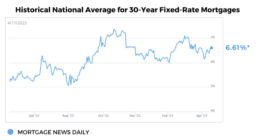
It was one year ago this month that the World Health Organization declared that the “Coronavirus” (old-fashioned name for COVID) was a “pandemic.”
And holy smokes has the world changed (understatement of the year).
Here are some of COVID’s major effects on the Real Estate and Mortgage Industries:
1. INTEREST RATES
Even though rates have increased about 1/2% over the last few months, they remain about 3/8% LOWER than where they were last year at this time on average.
This is b/c rates dropped about 1% in response to the COVID crisis and the Fed’s intervention before starting to climb.
2. COVID OVERLAYS (More Restrictive Lending)
Overlays are additional guidelines that lenders impose over and above standard lending guidelines, and some of the COVID overlays are particularly strict.
This is especially the case with self-employed borrowers, as lenders want to ensure they are still making similar amounts of money in our post-COVID economy.
As a result, many lenders have imposed much tighter debt ratio requirements for self-employed borrowers along with requirements that they prove they are still in business and generating revenues.
We have seen borrowers with very strong 2020 incomes not qualify for mortgages this year b/c they have not yet generated revenues or income.
3. FORBEARANCES
2.7 million mortgages were in forbearance at the end of 2020, scaring the bejeebers out of many market analysts who feared that these would turn into foreclosures that would flood the market with inventory.
As a reminder, a forbearance is a gov’t mandate that allows borrowers in hardship to stop making payments on their mortgages without risk to their credit.
According to many analysts, like Barry Habib, forbearance concerns are very overblown for the following reasons:
- Didn’t Need It: Many borrowers went into forbearance as a precaution but did not need to, so they can easily start making payments again;
- Equity: Most borrowers have substantial equity in their properties, in sharp contrast to 2009, and will do whatever they need to in order to preserve it (so they won’t let their houses go to foreclosure);
- Friendly Repayment Terms: Forbearance repayment rules are very friendly, as there will be no interest or payments due and borrowers only have to repay past due balances when they refi or sell; and
- Easy To Sell: The hot market makes it very easy for borrowers in true hardship situations to sell without letting the house go to foreclosure.
4. REMOTE WORK MAKES WORLD MORE COMPETITIVE
This is a factor that most of us missed in the mortgage and real estate worlds b/c our markets have been so hot over the last year.
But, when things cool down even a little, the world will get far more competitive.
This is b/c businesses have figured out how to cut costs with remote work and consumers are now much more willing to engage remotely.
Businesses have learned to cut costs by eliminating office space and by accessing far cheaper remote labor markets either overseas or in middle America, and that in turn allows them to offer lower rates, prices and/or commissions.
It is also much easier to open up a business when clients and employees are willing and able to work or engage remotely, so I expect everything to get far more competitive over the next few years in both the real estate and mortgage realms.
5. MUCH HOTTER HOUSING MARKET
This is something nobody saw coming last year when COVID concerns surfaced, particularly when lockdowns were imposed.
Here are several reasons why the housing market got way hotter than anyone expected:
- Lower Rates: Falling interest rates made housing more affordable and attractive, and thus spurred demand.
- Higher Asset Prices/Flood of Money: Very low interest rates, quantitative easing and lots of Fed money creation (in any form), usually pushes up asset prices, e.g. stocks, and makes the homebuying population feel flush with cash and more willing to buy.
- Unemployment Hit Renters: Over 20 million people lost their jobs as a result of the COVID crisis, and 10 million of those people remain unemployed. This is extremely serious and very sad, but it did not affect the housing market in the way that many feared b/c it hit non-homebuying demographics much harder. Many potential homebuyers actually did better in 2020. Examples include those of us in the real estate, title, appraisal and mortgage industries along with many tech workers.
- Lower Inventory: COVID stopped many developers from building for months, further exacerbating inventory shortages and the supply/demand imbalance.
- Demographic Demand: There is a surge of millennials just now hitting homebuying age, and this too is impacting the supply/demand imbalance.
Jay Voorhees
Founder/Broker | JVM Lending
(855) 855-4491 | DRE# 1197176, NMLS# 310167
























